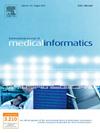预测缺血性卒中患者再入院的可能性:使用通用数据模型数据的可解释的机器学习方法。
IF 3.7
2区 医学
Q2 COMPUTER SCIENCE, INFORMATION SYSTEMS
International Journal of Medical Informatics
Pub Date : 2024-12-26
DOI:10.1016/j.ijmedinf.2024.105754
引用次数: 0
摘要
背景:全世界有1500万人患有缺血性中风,每年造成500万人死亡。尽管死亡率下降,但卒中发病率和再入院风险仍然很高,这突出表明需要预防再入院,以改善幸存者的生活质量。本研究开发了一种机器学习模型,使用韩国江原道地区责任医疗医院转换为公共数据模型(CDM)的电子病历来预测90天的中风再入院。方法:我们回顾性分析了2003年8月至2021年8月期间入院的1136例缺血性脑卒中患者的数据,排除了血液检查值缺失的病例。人口统计学、血检结果、治疗和合并症被用作主要特征。使用6个机器学习模型和3个深度学习模型来预测90天的再入院,使用合成少数过度抽样技术来解决班级不平衡问题。采用三重交叉验证对模型进行评估,并计算SHapley加性解释(SHAP)值来解释特征重要性。结果:1136例患者中,196例(17.2%)在90天内再次入院。男性患者再入院的可能性显著增加(p = 0.02)。LightGBM的曲线下面积为0.94,表明分析中风和中风相关情况比单独预测中风或全因再入院提供了更高的预测准确性。SHAP分析强调肾脏和代谢变量,包括肌酐、血尿素氮、钙、钠和钾,是再入院的关键预测因素。结论:使用基于电子健康记录的CDM数据的机器学习模型对90天卒中再入院表现出强大的预测性能。这些结果支持个性化的出院后管理,并为未来的多中心研究奠定基础。本文章由计算机程序翻译,如有差异,请以英文原文为准。
Predicting the likelihood of readmission in patients with ischemic stroke: An explainable machine learning approach using common data model data
Background
Ischemic stroke affects 15 million people worldwide, causing five million deaths annually. Despite declining mortality rates, stroke incidence and readmission risks remain high, highlighting the need for preventing readmission to improve the quality of life of survivors. This study developed a machine-learning model to predict 90-day stroke readmission using electronic medical records converted to the common data model (CDM) from the Regional Accountable Care Hospital in Gangwon state in South Korea.
Methods
We retrospectively analyzed data from 1,136 patients with ischemic stroke admitted between August 2003 and August 2021 after excluding cases with missing blood test values. Demographics, blood test results, treatments, and comorbidities were used as key features. Six machine learning models and three deep learning models were used to predict 90-day readmission using the synthetic minority over-sampling technique to address class imbalance. Models were evaluated using threefold cross-validation, and SHapley Additive exPlanations (SHAP) values were calculated to interpret feature importance.
Results
Among 1,136 patients, 196 (17.2 %) were readmitted within 90 days. Male patients were significantly more likely to experience readmission (p = 0.02). LightGBM achieved an area under the curve of 0.94, demonstrating that analyzing stroke and stroke-related conditions provides greater predictive accuracy than predicting stroke alone or all-cause readmissions. SHAP analysis highlighted renal and metabolic variables, including creatinine, blood urea nitrogen, calcium, sodium, and potassium, as key predictors of readmission.
Conclusion
Machine-learning models using electronic health record-based CDM data demonstrated strong predictive performance for 90-day stroke readmission. These results support personalized post-discharge management and lay the groundwork for future multicenter studies.
求助全文
通过发布文献求助,成功后即可免费获取论文全文。
去求助
来源期刊

International Journal of Medical Informatics
医学-计算机:信息系统
CiteScore
8.90
自引率
4.10%
发文量
217
审稿时长
42 days
期刊介绍:
International Journal of Medical Informatics provides an international medium for dissemination of original results and interpretative reviews concerning the field of medical informatics. The Journal emphasizes the evaluation of systems in healthcare settings.
The scope of journal covers:
Information systems, including national or international registration systems, hospital information systems, departmental and/or physician''s office systems, document handling systems, electronic medical record systems, standardization, systems integration etc.;
Computer-aided medical decision support systems using heuristic, algorithmic and/or statistical methods as exemplified in decision theory, protocol development, artificial intelligence, etc.
Educational computer based programs pertaining to medical informatics or medicine in general;
Organizational, economic, social, clinical impact, ethical and cost-benefit aspects of IT applications in health care.
 求助内容:
求助内容: 应助结果提醒方式:
应助结果提醒方式:


